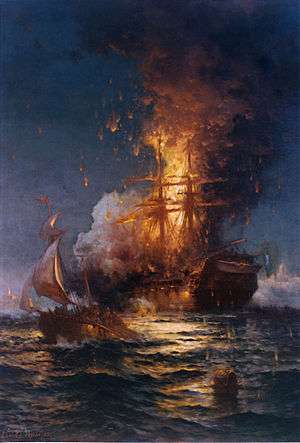Barbary Wars
| Barbary Wars | |||||||
|---|---|---|---|---|---|---|---|
 USS Philadelphia burning at the Battle of Tripoli Harbor during the First Barbary War in 1804 | |||||||
| |||||||
| Belligerents | |||||||
|
|
| ||||||
| Commanders and leaders | |||||||
| Stephen Decatur | |||||||
| Casualties and losses | |||||||
|
United States: 45 killed 94 wounded | 853 dead | ||||||
The Barbary Wars were a series of conflicts that culminated in two wars fought at different times over the same reasons between the United States, Sweden, and the Barbary states (the de jure possessions of the Ottoman Empire, but de facto independent, Tunis, Algiers, and Tripoli) of North Africa in the late 18th and early 19th centuries. The Swedes had been at war with the Tripolitans since 1800; they were eventually joined by the Americans.[3]
At issue was the Barbary pirates' demand for tribute from American merchant vessels in the Mediterranean Sea. If ships of a given country failed to pay, pirates would attack the ship and take their goods, and often enslave crew members or hold them for ransom.
When Thomas Jefferson became President of the United States in March 1801, he refused to pay tribute and sent a United States Naval fleet to the Mediterranean; the fleet bombarded various fortified pirate cities in present-day Libya, Tunisia, and Algeria, ultimately extracting concessions of fair passage from their rulers. James Madison, Jefferson's successor, directed military forces for the second war in 1815, shortly after the conclusion of the War of 1812 against the British.
Barbary corsairs
The Barbary corsairs, sometimes called Ottoman corsairs or Berber pirates, were pirates and privateers who operated from North Africa, based primarily in the ports of Tunis, Tripoli, and Algiers. This area was known in Europe as the Barbary Coast, a term derived from the name of its Berber inhabitants. Their predation extended throughout the Mediterranean, south along West Africa's Atlantic seaboard and even to the eastern coast of South America with Brazil,[4] and into the North Atlantic Ocean as far north as Iceland, but they primarily operated in the western Mediterranean. In addition to seizing ships, they engaged in razzias, raids on European coastal towns and villages, mainly in Italy, France, Spain, and Portugal, but also in England, Scotland, the Netherlands, Ireland, and as far away as Iceland. The main purpose of their attacks was to capture European slaves for the Arab slave market in North Africa.[5]
Attacks
Since the 1600s, the Barbary pirates had attacked British shipping along the North Coast of Africa, holding captives for ransom or enslaving them. Ransoms were generally raised by families and local church groups. The British became familiar with captivity narratives written by Barbary pirates' prisoners and slaves.[6]
During the American Revolutionary War, the pirates attacked American ships. On December 20, 1777, Morocco's sultan Mohammed III declared that merchant ships of the new American nation would be under the protection of the sultanate and could thus enjoy safe passage into the Mediterranean and along the coast. The Moroccan-American Treaty of Friendship stands as America's oldest unbroken friendship treaty[7][8] with a foreign power. In 1787, Morocco became one of the first nations to recognize the United States of America.[9]
Starting in the 1780s, realizing that American vessels were no longer under the protection of the British navy, the Barbary pirates had started seizing American ships in the Mediterranean. As the U.S. had disbanded its Continental Navy and had no seagoing military force, its government agreed in 1786 to pay tribute to stop the attacks.[10] On March 20, 1794, at the urging of President George Washington, the United States Congress voted to authorize the building of six heavy frigates and establish the United States Navy, in order to stop these attacks and demands for more and more money.[11] The United States had signed treaties with all of the Barbary states after its independence was recognized between 1786-1794 to pay tribute in exchange for leaving American merchantmen alone, and by 1797, the United States had paid out $1.25 million or a fifth of the government's annual budget then in tribute.[12] These demands for tribute had imposed a heavy financial drain and by 1799 the U.S. was in arrears of $140,000 to Algiers and some $150,000 to Tripoli.[13] Many Americans resented these payments, arguing that the money would be better spent on a navy that would protect American ships from the attacks of the Barbary pirates, and in the 1800 Presidential Election, Thomas Jefferson won in part against incumbent second President John Adams, in part by noting that the United States was "subjected to the spoliations of foreign cruisers" and was humiliated by paying "an enormous tribute to the petty tyrant of Algiers".[14]
First Barbary War (1801–1805)
The First Barbary War (1801–1805), also known as the Dodo War or the Barbary Coast War, was the first of two wars fought between the alliance of the United States and several European countries[15][16] against the Northwest African Berber Muslim states known collectively as the Barbary states. These were Tripoli and Algiers, which were quasi-independent entities nominally belonging to the Ottoman Empire, and (briefly) the independent Sultanate of Morocco. This war began during Thomas Jefferson's term when he refused to pay tribute, an amount that was greatly increased when he became president. A U.S. naval fleet was sent on May 13, 1801, at the beginning of the war under the command of Commodore Richard Dale. Other notable officers in the fleet included Stephen Decatur, assigned to the frigate USS Essex and William Bainbridge in command of Essex which was attached to Commodore Richard Dale's squadron which also included Philadelphia, President and Enterprise.[17]
During this war, the ship Philadelphia was blockading Tripoli's harbor when she ran aground on an uncharted reef. Under fire from shore batteries and Tripolitan gunboats, the Captain, William Bainbridge, tried to refloat her by casting off all of her guns and other objects that weighed it down. The ship was eventually captured and the crew taken prisoners and put into slavery. To prevent this powerful war ship from being used by the Barbary pirates the ship was later destroyed by a raiding party led by Stephen Decatur.[18][19]
Second Barbary War (1815)
The Second Barbary War (1815), also known as the Algerine or Algerian War, was the second of two wars fought between the United States and the Ottoman Empire's North African regencies of Tripoli, Tunis and Algeria, known collectively as the Barbary states. The war between the Barbary States and the U.S. ended in 1815; the international dispute would effectively be ended the following year by the United Kingdom and the Netherlands. The war brought an end to the American practice of paying tribute to the pirate states and helped mark the beginning of the end of piracy in that region, which had been rampant in the days of Ottoman domination (16th–18th centuries). Within decades, European powers built ever more sophisticated and expensive ships which the Barbary pirates could not match in numbers or technology.[20]
Effect in United States
When the United States military efforts of the early 19th century were successful against the pirates, partisans of the Democratic-Republicans contrasted their presidents' refusals to buy off the pirates by paying tribute with the failure of the preceding Federalist administration to suppress the piracy. The Federalist Party had adopted the slogan, "Millions for defense, but not one cent for tribute," but had failed to end the attacks on merchant ships. From 1796–1797 French raiders seized some 316 American merchant ships flying American colors. To counter this ongoing advent three frigates, USS United States, USS Constitution and USS Constellation, were soon built to answer the call for security.[21]
Later
In the 21st century, the United States again conducted military operation in the North African area, specifically participating in the intervention against the government of Libya, and this operation has sometimes been termed in the media as the continuation of the previous Barbary Wars and given the name "Third Barbary War".[22]
See also
- Thomas Macdonough—Fought in First Barbary War
- Charles Stewart—Fought in both Barbary wars
- Isaac Hull—Commander of the Enterprise
- William Eaton—Played an important diplomatic and military role in the First Barbary War.
- Dey of Algiers—ruler of Algeria who declared war on the United States
- Turkey–United States relations
- Algeria–United States relations
- Tunisia–United States relations
- Libya–United States relations
References
- ↑ "Start Here! About the Barbary Wars". daddezio.com.
- ↑ Joseph Wheelan (21 September 2004). Jefferson's War: America's First War on Terror 1801–1805. PublicAffairs. pp. 128–. ISBN 978-0-7867-4020-8.
- ↑ Woods, Tom. "Presidential War Powers: The Constitutional Answer". Libertyclassroom.com. Retrieved 9 July 2014.
- ↑ A 44-gun Algerian corsair appeared at Río de la Plata in 1720. Cesáreo Fernández Duro, Armada española desde la unión de los reinos de Castilla y de León, Madrid, 1902, Vol. VI, p. 185
- ↑ "British Slaves on the Barbary Coast".
- ↑ Linda Colley, Captives: Britain, Empire, and the World, 1600–1850, New York: Anchor Books Edition, 2000
- ↑ Roberts, Priscilla H. and Richard S. Roberts, Thomas Barclay 1728–1793: Consul in France, Diplomat in Barbary, Lehigh University Press, 2008, pp. 206–223.
- ↑ "Milestones of American Diplomacy, Interesting Historical Notes, and Department of State History". U.S. Department of State. Retrieved 2007-12-17.
- ↑ "Cohen Renews U.S.-Morocco Ties" (mil). U.S. Department of Defense. Retrieved 2009-03-12.
- ↑ Fremont-Barnes, Gregory The Wars of the Barbary Pirates, London: Osprey, 2006 pages 32-33
- ↑ Fremont-Barnes, Gregory The Wars of the Barbary Pirates, London: Osprey, 2006 page 33.
- ↑ Fremont-Barnes, Gregory The Wars of the Barbary Pirates, London: Osprey, 2006 pages 36-37
- ↑ Fremont-Barnes, Gregory The Wars of the Barbary Pirates, London: Osprey, 2006 page 37
- ↑ Fremont-Barnes, Gregory The Wars of the Barbary Pirates, London: Osprey, 2006 page 7
- ↑ "Tripolitan War". Encyclopedia.com (from The Oxford Companion to American Military History). 2000. Retrieved February 11, 2017.
- ↑ "War with the Barbary Pirates (Tripolitan War)". veteranmuseum.org. Retrieved February 11, 2017.
- ↑ Harris, 1837 pp.63–64, 251
- ↑ Tucker, 1937 p.57
- ↑ MacKenzie, 1846 pp.331–335
- ↑ Liener, 2007, pp.39–50
- ↑ Simons, 2003, p. 20
- ↑ Appelbaum, Yoni. "The Third Barbary War".
Bibliography
- Allen, Gardner Weld, (1905). Our Navy and the Barbary Corsairs.
Houghton Mifflin & Co., Boston, New York & Chicago. p. 354. E'book - Harris, Gardner W. (1837). The Life and Services of Commodore William Bainbridge, United States Navy.
:Carey Lea & Blanchard, New York. p. 254. . E'book - Leiner, Frederic C. (2007). The End of Barbary Terror, America's 1815 War Against the Pirates of North Africa.
Oxford University Press. p. 240. ISBN 978-0-19-532540-9. Book (par view) - Mackenzie, Alexander Slidell (1846). Life of Stephen Decatur: a commodore in the Navy of the United States.
C. C. Little and J. Brown, 1846. - Simmons, Edwin H. (2003). The United States Marines: A History.
Naval Institute Press. p. 405. ISBN 9781557508683. , Book (par view) - Tucker, Spencer (2004). Stephen Decatur: a life most bold and daring.
Naval Institute Press, 2004, Annapolis, Maryland. p. 245. ISBN 1-55750-999-9. Book (par view)
Further reading
- Bibliography of early American naval history
- London, Joshua E. Victory in Tripoli: How America's War with the Barbary Pirates Established the U.S. Navy and Shaped a Nation. New Jersey: John Wiley & Sons, Inc., 2005. ISBN 0-471-44415-4
- Oren, Michael. "Early American Encounters in the Middle East", in Power, Faith, and Fantasy. New York: Norton, 2007.
- Boot, Max. The Savage Wars of Peace: Small Wars and the Rise of American Power. New York: Basic Books, 2002. ISBN 0-465-00720-1
- Lambert, Frank. The Barbary Wars. New York: Hill and Wang, 2005.
- Whipple, A. B. C. To the Shores of Tripoli: The Birth of the U.S. Navy and Marines. Bluejacket Books, 1991. ISBN 1-55750-966-2
External links
- The Barbary Wars at the Clements Library:An online exhibit on the Barbary Wars with images and transcriptions of primary documents from the period.
